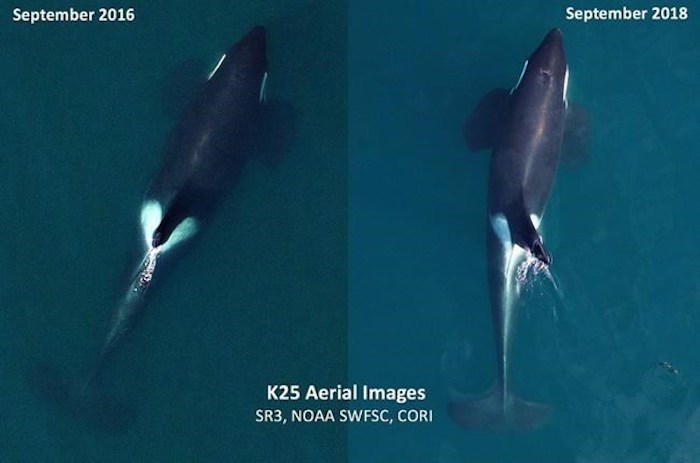A joint Canada-U.S. report on the health of the Salish Sea has found either an overwhelming decline or stable trend in nine out of 10 environmental indicators tracked over the last several years.
The only positive? Shellfish.
The "Health of the Salish Sea Report" from the U.S. Environmental Protection Agency and Environment and Climate Change Canada offers a glimpse of how the sea — which includes the Straight of Juan de Fuca, Puget Sound and the Georgia Basin — is being sustainably managed and where the integrity of the ecosystem is on the decline.
While the first cross-border Salish Sea report was published in 2002, this is the first time it's been fully updated since 2013.
“Today, about 8.7 million people live in the areas around the Salish Sea and benefit from the resources that the ecosystem provides. By the year 2040, we can expect the population in the Salish Sea ecosystem to expand to over 10.5 million people,” write the authors.
“Sustainable stewardship of the Salish Sea ecosystem is critical to our continued use and enjoyment of this place.”
SPECIES AT RISK
The number of marine species at risk was found to have doubled in Puget Sound and the Strait of Georgia between 2002 and 2015. Keystone species like Chinook salmon and southern resident killer whales were both found to be on the decline.
One species' decline cannot be separated from the other: In addition to acoustic stressors, vessel impacts and exposure to contaminants, the consistently low availability of Chinook salmon — the Southern Resident killer whale's primary food source — increasingly threatens its survival, note the authors.
In 2018, roughly 473,000 Chinook salmon passed through the Salish Sea. That's a 60 per cent decline from 1984, notes the report. The species faces pressures from the destruction of spawning habitat, hatcheries, ocean predation and over-fishing.
At the same time, climate change is challenging Chinook survival as they return to spawn. For example, in the summer, decreased streamflows are compounded by spikes in water temperature.
“Even small shifts in water temperature could alter the timing of migration, reduce growth, reduce [the] availability of oxygen in the water, reduce [the] availability of preferred food sources, and increase the susceptibility to toxins, parasites and disease” write the authors of the report.
And while toxic pollutants like polychlorinated biphenyls (PCBs) have been decreasing across many locations, microplastics were flagged as an “emerging threat” that requires more research to understand its full effects.
AIR AND WATER
Air quality, defined by fine particulate matter in the air, was on a neutral trend. Of the 13 air quality stations the researchers sampled, two stations in Hope and Chilliwack failed a 24-hour standard.
The researchers said that while the region has made significant gains in reducing air pollution, wildfire smoke made worse by human-induced climate change threatens to erase that progress.
The health of water bodies appears stable overall. But that masks some important distinctions.
“Of the 20 rivers assessed since 2010, two rivers showed decreasing water quality,” wrote the researchers.
“In particular, the Fraser River score declined from our Good classification to the Fair/Marginal classification.”
Since 1975, eight of the 17 rivers monitored in B.C. and Washington “showed significant decreasing summer flow trends.”
Also on the decline: marine water quality in the Strait of Georgia and Puget Sound.
HUMAN WELL-BEING
The bright spot? Humans, at least when it comes to improved access to shellfish harvesting and clean beaches.
Across the border in Puget Sound, more than 6,400 acres of previously closed shellfish beds were upgraded or re-opened between 2007 and 2019. That was mainly due to improvements in water quality, despite a growing population and increased urbanization.
In B.C., automatic shellfish harvesting prohibitions were expanded in 2012 after new health-risk advice raised questions over the persistence of viruses near wastewater treatment outfalls. Shellfish bed closures have spiked since then.
That’s not the case when it comes to the closure of swimming beaches. In 2018, 95 per cent of the beaches on the Canadian side of the border met Canadian water quality guidelines, found the report.
In Puget Sound, only 74 per cent of beaches passed water quality standards between 2004 and 2018.
The report found beach closures were the result of:
- Malfunctioning sewage treatment plants and discharges from combined sewers;
- improperly maintained septic systems;
- sewage from recreational boaters;
- rainwater runoff carrying pet and other animal waste;
- and a high number of swimmers.
BI-LATERAL ’ACTION PLAN’ SIGNED
Canada and the U.S. announced Wednesday they had renewed their cooperation with the signing of a four-year ‘Action Plan’ that commits both sides to find solutions to deteriorating ecosystems across the Salish Sea.
Among its recommendations, the action plan calls for continued trans-border monitoring of the shared ecosystem and collaboration between federal, state and provincial, and First Nations governments.
“These waters are the lifeblood of the millions who live in the communities of the region,” said Michelle Pirzadeh, the EPA’s acting regional administrator for its Seattle office. “…we’re confident that the partnerships and information sharing will produce positive results for our environment in the coming years and decades.”
Stefan Labbé is a solutions journalist. That means he covers how people are responding to problems linked to climate change — from housing to energy and everything in between. Have a story idea? Get in touch. Email [email protected].



